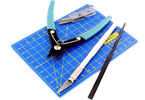Description
Academy plastic model military Ground Veghicle Series-1 in 1:72 scale for gluing.
Template information:
The Volkswagen Schwimmwagen (literally "covered wagon") was an all-wheel drive amphibious vehicle used extensively by German ground forces during World War II. The Schwimmwagen is the most mass-produced amphibious vehicle in history.
The Schwimmwagens were manufactured by the Volkswagen plant in Fallersleben / Stadt des KdF-Wagens and the Porsche plant in Stuttgart. With bodies (or rather torso) made by Ambi Budd in Berlin. 15,584 Type 166 Schwimmwagens were produced between 1941 and 1944, 14,276 in Fallersleben and 1,308 at Porsche. It is known from the Schwimmwagen register that today only 189 amphibious cars remained and only 13 survived without restoration work.
All Schwimmwagens had four-wheel drive in first gear (and in some models reverse) and had ZF self-locking differentials on the front and rear axles. As with the Kübelwagen, the Schwimmwagen had rear gantry axles that provided increased ground clearance while reducing powertrain stress by reducing wheel gears. The Schwimmwagen had a top speed of 50 miles per hour (80 km / h) on land.
While crossing the water, it was possible to lower the propeller down from the rear cover of the deck / engine. When a simple clutch was in place, it provided drive directly from the engine crankshaft extension. This meant that the screw drive always went forward. The Schwimmwagen had a top speed of 10 km / h (6 mph) in the water. For reversing in the water, the choice was to use standard paddle equipment or start the ground drive in the opposite direction, which allowed the wheels to turn slowly to return the vehicle. The front wheels doubled like rudders, so steering was done on land and water. Schwimmwagen could also be driven by the above-mentioned paddles.
In 1940, when World War I began, the United States General Staff launched a competition to design a light four-wheel drive vehicle that would serve many purposes. American Bantam Company, Willys Overland Motor and Ford Motor Co. participated in the race. The choice fell on the Willys, which, after a pre-series of 1,500 vehicles since 1941, was put on assembly lines and produced more than 640,000 units, of which 277,000 under license from Ford. This means that "Jeep" was a vehicle built in the largest number of specimens by the war industry during World War II.
Kettenkrad is a combination of a motorcycle and a tracked vehicle. It was designed in the late 1930s at NSU Motorenwerke. In 1941 he officially entered the service of the Wehrmacht. Ideal for uneven terrain as a light tug, tractor or van. He could wear machine guns, mortars and drums with telephone cables. Only two significant partial variants of the Kettenkrad were built. Production of the vehicle was stopped in 1944, when 8,345 units were produced. After the war, production at the NSU was resumed. Around 550 Kettenkräder were built for agricultural purposes, with production ceasing in 1948 (some sources state 1949).
The Kettenkräder saw service on the Eastern Front, where they were used to lay communication cables, haul heavy loads and transport troops through deep Russian mud. Later in the war, the Kettenkräder were used as runway tugs for aircraft, especially the Messerschmitt Me 262 jet fighter and sometimes the Arado Ar 234 jet reconnaissance bomber. To save aviation fuel, German jets were towed to the runway.











